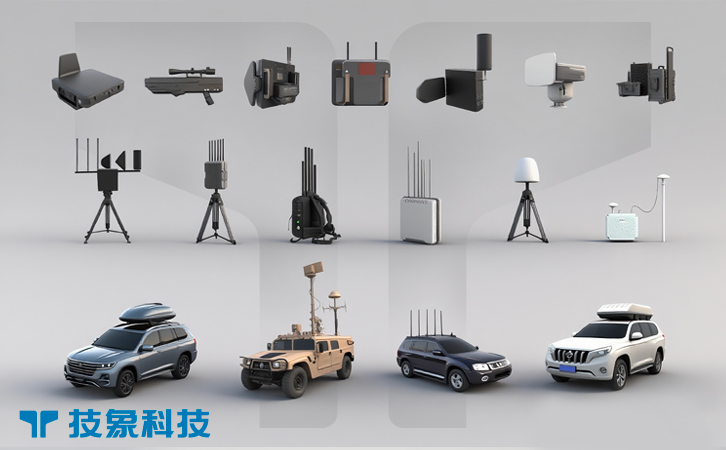The proliferation of unmanned aerial vehicles (UAVs), including sophisticated autonomous drones and swarms, has escalated the demand for advanced anti-UAV defense systems. Artificial Intelligence (AI) is at the forefront of transforming these systems, enabling faster, more accurate detection, tracking, and neutralization of drone threats. By leveraging machine learning, computer vision, and predictive analytics, AI enhances the capabilities of anti-UAV systems to address complex challenges in dynamic environments, such as urban areas, military bases, or public events. This article explores the pivotal role of AI in next-generation anti-UAV systems, detailing its contributions to detection, classification, countermeasure optimization, and system autonomy, and highlighting its strategic importance in securing airspace.
I. AI-Driven Detection and Tracking
AI significantly enhances the detection and tracking of drones, addressing the limitations of traditional systems like radar and radiofrequency (RF) sensors. Machine learning algorithms process data from multiple sensors—radar, RF, electro-optical (EO), infrared (IR), and acoustic—to identify drones in real time, even in cluttered environments. For instance, convolutional neural networks (CNNs) analyze radar signatures to distinguish small UAVs from birds or debris, reducing false positives that can disrupt operations. In urban settings, where buildings and electronic noise interfere with radar, AI integrates multi-sensor data to create a comprehensive threat picture, improving detection accuracy.
Tracking multiple drones, especially in swarm scenarios, is a complex task that AI handles with precision. Reinforcement learning models predict drone trajectories by analyzing flight patterns, enabling continuous monitoring of fast-moving or evasive UAVs. For example, systems like the U.S. Army’s M-LIDS (Mobile-Low, Slow, Small Unmanned Aircraft Integrated Defeat System) use AI to track dozens of targets simultaneously, providing real-time updates to command-and-control (C2) systems. AI also enhances EO/IR systems by using computer vision to follow drones visually, even in low-visibility conditions like fog or darkness. These capabilities ensure robust detection and tracking, enabling anti-UAV systems to respond swiftly to dynamic threats across diverse operational contexts.
II. Intelligent Classification and Threat Assessment
Accurate classification of detected objects is critical to avoid engaging non-threatening entities, such as authorized drones or natural phenomena. AI excels in this area by leveraging supervised and unsupervised learning to analyze sensor data and classify objects with high precision. Deep learning models, trained on vast datasets of drone signatures, RF signals, and visual profiles, can differentiate between consumer-grade quadcopters, military UAVs, or non-drone objects like birds. For instance, AI algorithms can analyze RF signal patterns to identify a drone’s model or intent, distinguishing a hobbyist drone from a malicious one carrying a payload.
Threat assessment is another key function, where AI evaluates the risk level of a detected drone based on factors like flight path, altitude, speed, and payload indicators. Bayesian networks or decision trees enable real-time risk scoring, prioritizing high-threat targets in swarm scenarios. For example, an AI system might flag a drone approaching a military base at low altitude as a high-priority threat, triggering immediate countermeasures. These models also adapt to new threats by learning from real-world incidents, such as the 2019 drone attack on Saudi oil facilities, ensuring continuous improvement in classification accuracy. By automating and refining threat assessment, AI minimizes human error and enhances the efficiency of anti-UAV operations.
III. Optimizing Countermeasures with AI
AI plays a transformative role in optimizing countermeasures, ensuring rapid and effective neutralization of drone threats. Machine learning algorithms select the most appropriate countermeasure—RF jamming, high-powered microwaves (HPM), lasers, or net-based capture—based on the threat’s characteristics and environmental constraints. For instance, in urban areas, AI might prioritize non-kinetic solutions like targeted RF jamming to avoid collateral damage, while in military settings, it could deploy lasers like Raytheon’s HELWS for precise kinetic engagement. Reinforcement learning enables systems to adapt countermeasure strategies dynamically, such as adjusting jamming frequencies to counter evasive drones or prioritizing targets in a swarm.
AI also enhances the precision of countermeasures. In laser-based systems, computer vision guides beams to critical drone components, such as rotors or electronics, maximizing efficiency and minimizing power consumption. For swarm defense, AI-driven HPM systems, like the U.S. Air Force’s THOR, optimize pulse distribution to disable multiple drones simultaneously. Predictive analytics further improve outcomes by anticipating drone maneuvers, allowing preemptive countermeasure deployment. For example, an AI model might predict a swarm’s dispersal pattern and adjust an HPM’s coverage area accordingly. By automating and optimizing countermeasure selection and execution, AI ensures scalable, effective responses to complex drone threats.
IV. Autonomy and Scalability in Anti-UAV Systems
The integration of AI enables anti-UAV systems to operate with greater autonomy, reducing reliance on human operators and enhancing scalability. Autonomous C2 systems, powered by AI, process sensor data, classify threats, and deploy countermeasures without manual intervention, critical for time-sensitive scenarios like swarm attacks. For instance, AI-driven platforms can autonomously switch between detection modes or countermeasures based on real-time threat assessments, achieving response times under a second. This level of autonomy is vital in high-pressure environments, such as protecting a crowded stadium during a major event.
Scalability is another benefit, as AI enables systems to handle increasing numbers of drones or larger operational areas. Neural networks optimize resource allocation, ensuring that detection and countermeasure assets are deployed efficiently across wide areas, such as airports or military bases. Integration with 5G networks and edge computing further enhances scalability by enabling real-time data processing and coordination across multiple anti-UAV units. For example, a networked AI system could synchronize portable jammers and fixed radars to cover a city-wide event, creating a seamless defense grid. Future advancements in generative AI could enable systems to simulate and counter new drone behaviors, ensuring adaptability to emerging threats. This autonomy and scalability make AI-driven anti-UAV systems versatile and future-proof.
Conclusion
Artificial Intelligence is revolutionizing next-generation anti-UAV systems by enhancing detection, classification, countermeasure optimization, and system autonomy. Through advanced machine learning, computer vision, and predictive analytics, AI enables precise, rapid, and scalable responses to increasingly sophisticated drone threats, from single UAVs to autonomous swarms. As drone technology evolves, AI’s ability to adapt and learn will be critical for maintaining airspace security. By integrating AI into anti-UAV defenses, organizations can protect critical infrastructure, military assets, and public safety with unprecedented efficiency, paving the way for a resilient and adaptive defense ecosystem in an era of complex aerial challenges.



